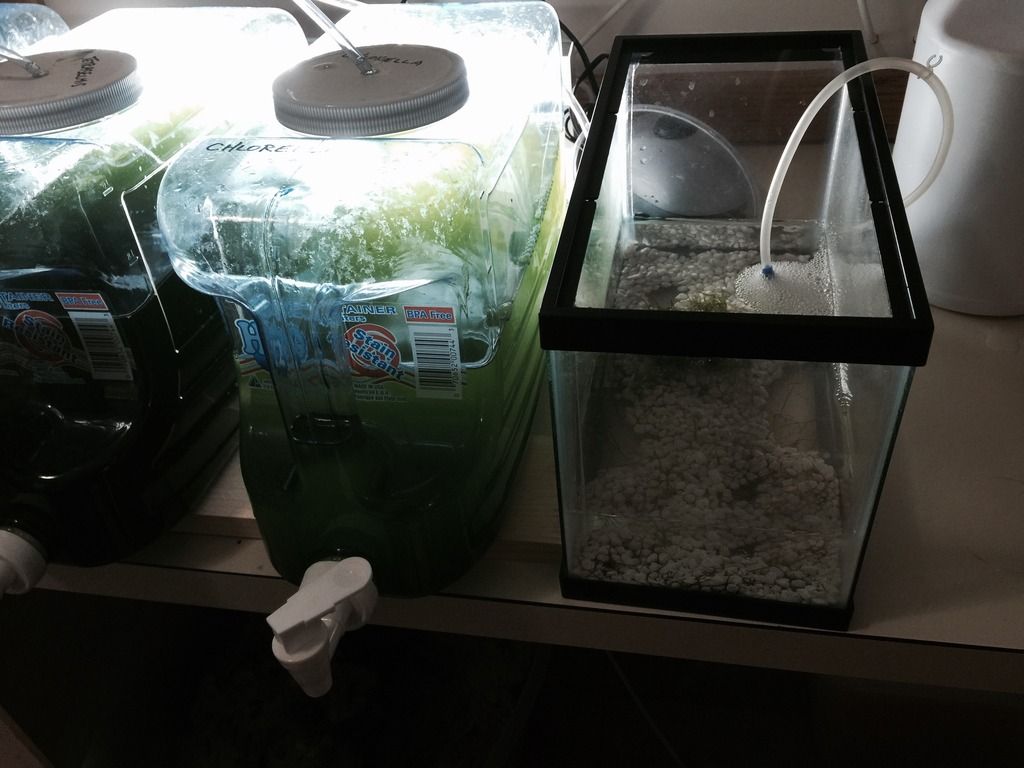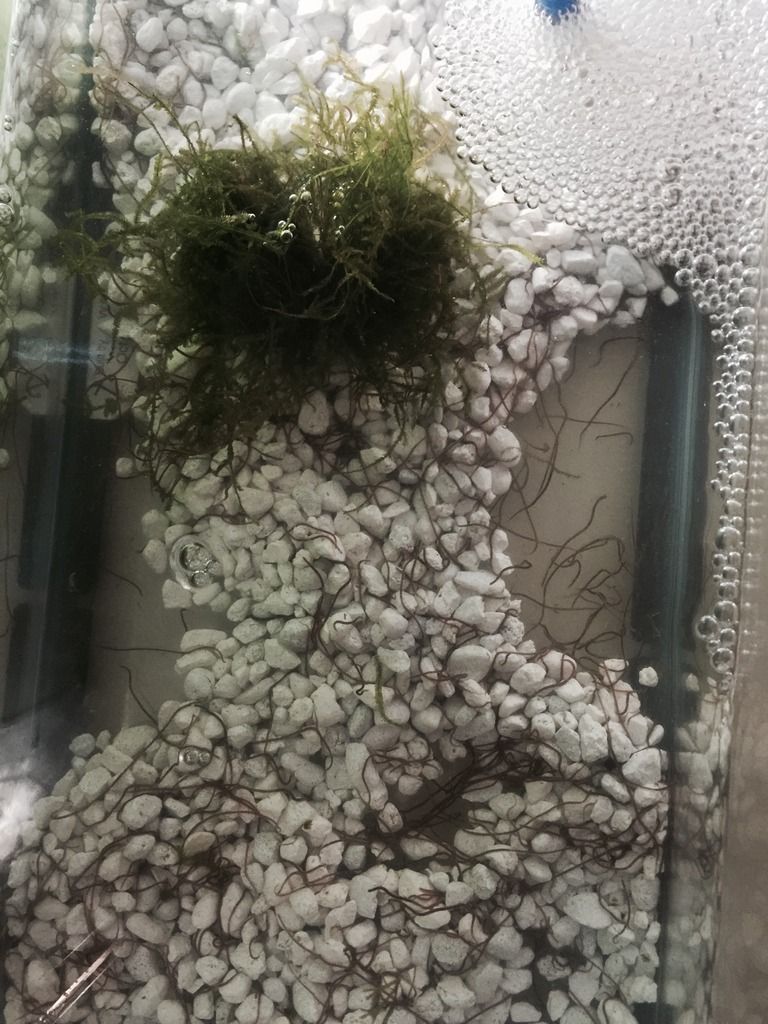Thanks go to Paul B for getting me into this. It's probably the best thing I've done for my fish, though I am still waiting for the supermodels to show up.
Please keep in mind this guide is written for 70-90g tanks. You may have to upscale a bit for a larger system. I'm unsure if it would work, as I've no experience with larger systems, but its so simple I can't see how doubling or tripling the information below would be non-viable.
Also, no need to overthink. This is as easy as it gets. I had a catastrophic disaster and lost my entire previous tank. Took me all of 10 minutes and a trip to buy the worms to get back up and running.
Set-up
Take a small tank, I use a 5 gallon.
Shallow fill (3-5”, more is not better) with RODI or tap water (NO SALT).
Place a single layer of gravel on the bottom (again, more is not better, its detrimental).
Use a small air pump and a generic air-stone.
Add a small plant or two for nitrates (any shallow freshwater plant will do, I’m currently using a bit of java moss) and just let it float about.
Add worms.
Thats it.
Securing worms
Tropaquarium in Ocean sells live worms for $1.50 a tub, 3 tubs for $4. Three tubs should be enough to start up, six would be better if you want to start feeding immediately. When choosing the tubs observe the worms. Greyish worms are dead. White worms that are mobile are leeches (rare). Choose tubs with a good amount of brown and mobile worms (regardless of where you purchase).
Drop the worms into the tank and stir it up a bit. Within a few minute the tank will appear empty as the worms will seek shelter under the gravel.
Feeding the worms
You really don’t need to. They can survive off the plant matter and residuals. But they do, in my experience, like kale, seaweed, and lettuce and will gather near it.
Water changes
Every once in a while I tend to use a plastic cup to remove a cup or so of water and then replace it with a cup of RODI (or tap if you prefer).
Temperature
Room temperature is fine but slightly chilled is better. No heaters.
Lighting
Whatever the room lighting is.
Here’s how you get more worms
Blackworms reproduce by fragmentation. A scraping or split of the worm creates another, thus the gravel, you want them moving around in it.
I agitate the gravel with a turkey baster every night, causing a bit of fragmenting disturbance.
I’ve also found that the worms like to gather near a supplemental food source. So, I attach a small piece of lettuce to a clip and drop it into a corner of the tank. The next day I move the food to the opposite end of the tank. They crawl to it, split and form more worms.
Harvesting
A simple turkey baster is used to agitate the substrate and to collect worms. Simply suck up some water, blast it slowly into the gravel, and suck up some of the worms that are disturbed. Dispense into a cup or a container. The worms are heavy and will sink to the bottom, plus they cluster up into a ball, so you can pour most of the collected water out.
Feeding
Just dip the cup or container into tank water to fill it up. The worms will break from the ball they formed and start darting in all directions due to the salt. Then, pour into tank. You’ll be amazed at how quickly the worms disappear.
Stocking
It takes about 2 weeks for a worm to become viable from a fragmentation. If you purchase a small amount of worms and initially feed sparingly, you should be able to maintain and build your population. If you feed heavily you can use your tank as a live food storage and just refill when necessary.
A couple of shots showing simple tank setup and then slightly agitated tank...


Please keep in mind this guide is written for 70-90g tanks. You may have to upscale a bit for a larger system. I'm unsure if it would work, as I've no experience with larger systems, but its so simple I can't see how doubling or tripling the information below would be non-viable.
Also, no need to overthink. This is as easy as it gets. I had a catastrophic disaster and lost my entire previous tank. Took me all of 10 minutes and a trip to buy the worms to get back up and running.
Set-up
Take a small tank, I use a 5 gallon.
Shallow fill (3-5”, more is not better) with RODI or tap water (NO SALT).
Place a single layer of gravel on the bottom (again, more is not better, its detrimental).
Use a small air pump and a generic air-stone.
Add a small plant or two for nitrates (any shallow freshwater plant will do, I’m currently using a bit of java moss) and just let it float about.
Add worms.
Thats it.
Securing worms
Tropaquarium in Ocean sells live worms for $1.50 a tub, 3 tubs for $4. Three tubs should be enough to start up, six would be better if you want to start feeding immediately. When choosing the tubs observe the worms. Greyish worms are dead. White worms that are mobile are leeches (rare). Choose tubs with a good amount of brown and mobile worms (regardless of where you purchase).
Drop the worms into the tank and stir it up a bit. Within a few minute the tank will appear empty as the worms will seek shelter under the gravel.
Feeding the worms
You really don’t need to. They can survive off the plant matter and residuals. But they do, in my experience, like kale, seaweed, and lettuce and will gather near it.
Water changes
Every once in a while I tend to use a plastic cup to remove a cup or so of water and then replace it with a cup of RODI (or tap if you prefer).
Temperature
Room temperature is fine but slightly chilled is better. No heaters.
Lighting
Whatever the room lighting is.
Here’s how you get more worms
Blackworms reproduce by fragmentation. A scraping or split of the worm creates another, thus the gravel, you want them moving around in it.
I agitate the gravel with a turkey baster every night, causing a bit of fragmenting disturbance.
I’ve also found that the worms like to gather near a supplemental food source. So, I attach a small piece of lettuce to a clip and drop it into a corner of the tank. The next day I move the food to the opposite end of the tank. They crawl to it, split and form more worms.
Harvesting
A simple turkey baster is used to agitate the substrate and to collect worms. Simply suck up some water, blast it slowly into the gravel, and suck up some of the worms that are disturbed. Dispense into a cup or a container. The worms are heavy and will sink to the bottom, plus they cluster up into a ball, so you can pour most of the collected water out.
Feeding
Just dip the cup or container into tank water to fill it up. The worms will break from the ball they formed and start darting in all directions due to the salt. Then, pour into tank. You’ll be amazed at how quickly the worms disappear.
Stocking
It takes about 2 weeks for a worm to become viable from a fragmentation. If you purchase a small amount of worms and initially feed sparingly, you should be able to maintain and build your population. If you feed heavily you can use your tank as a live food storage and just refill when necessary.
A couple of shots showing simple tank setup and then slightly agitated tank...


Last edited:

